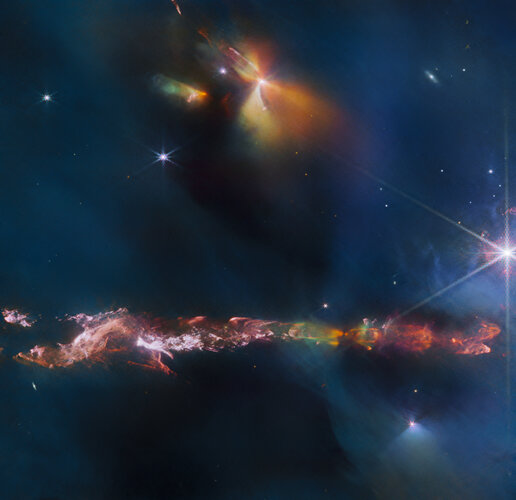This new Picture of the Month from the NASA/ESA/CSA James Webb Space Telescope reveals intricate details of the Herbig Haro object 797 (HH 797). Herbig-Haro objects are luminous regions surrounding newborn stars (known as protostars), and are formed when stellar winds or jets of gas spewing from these newborn stars form shockwaves colliding with nearby gas and dust at high speeds. HH 797, which dominates the lower half of this image, is located close to the young open star cluster IC 348, which is located near the eastern edge of the Perseus dark cloud complex. The bright infrared objects in the upper portion of the image are thought to host two further protostars.
This image was captured with Webb’s Near-InfraRed Camera (NIRCam). Infrared imaging is powerful in studying newborn stars and their outflows, because the youngest stars are invariably still embedded within the gas and dust from which they are formed. The infrared emission of the star’s outflows penetrates the obscuring gas and dust, making Herbig-Haro objects ideal for observation with Webb’s sensitive infrared instruments. Molecules excited by the turbulent conditions, including molecular hydrogen and carbon monoxide, emit infrared light that Webb can collect to visualise the structure of the outflows. NIRCam is particularly good at observing the hot (thousands of degree Celsius) molecules that are excited as a result of shocks.
Using ground-based observations, researchers have previously found that the for cold molecular gas associated with HH 797, most of the red-shifted gas (moving away from us) is found to the south (bottom right), while the blue-shifted gas (moving towards us) is to the north (bottom left). A gradient was also found across the outflow, such that at a given distance from the young central star, the velocity of the gas near the eastern edge of the jet is more red-shifted than that of the gas on the western edge. Astronomers in the past thought this was due to the outflow’s rotation. In this higher resolution Webb image, however, we can see that what was thought to be one outflow is in fact made up of two almost parallel outflows with their own separate series of shocks (which explains the velocity asymmetries). The source, located in the small dark region (bottom right of centre), and already known from previous observations, is therefore not a single but a double star. Each star is producing its own dramatic outflow. Other outflows are also seen in this image, including one from the protostar in the top right of centre along with its illuminated cavity walls.
HH 797 resides directly north of HH 211 (separated by approximately 30 arcseconds), which was the feature of a Webb image release in September 2023.
[Image Description: In the lower half of the image is a narrow, horizontal nebula that stretches from edge to edge. It is brightly coloured with more variety on its right side. In the upper half there is a glowing point with multi-coloured light radiating from it in all directions. A bright star with long diffraction spikes lies along the right edge, and a few smaller stars are spread around. The background is covered in a thin haze.]



 Image:
Image: